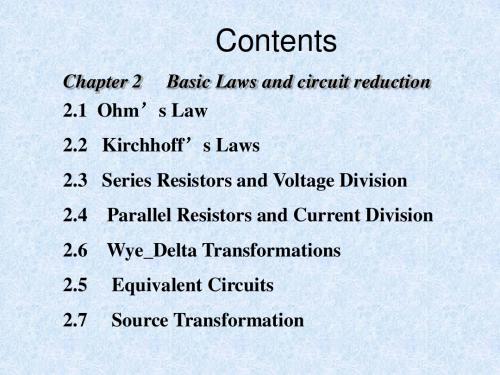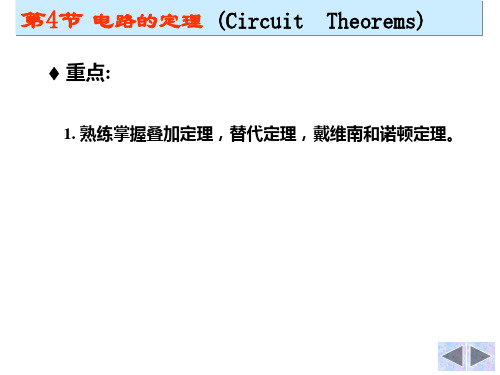电路理论Chapter 2
- 格式:pps
- 大小:330.50 KB
- 文档页数:16


电路原理2电路原理2是电子信息类专业的一门重要课程,它是电路原理1的延伸和深化,主要介绍了更加复杂的电路理论和应用。
在这门课程中,我们将学习更多关于电路的知识,包括交流电路、数字电路、集成电路等内容。
本文将重点介绍电路原理2中的一些重要知识点,帮助大家更好地理解和掌握这门课程。
首先,我们将介绍交流电路的基本概念。
交流电路是指电流和电压都随时间变化的电路,它在电子设备和通信系统中有着广泛的应用。
在交流电路中,我们需要了解频率、相位、阻抗等基本概念,并掌握交流电路的分析方法和计算技巧。
其次,我们将学习数字电路的相关知识。
数字电路是由数字信号来控制和传输信息的电路,它在计算机、通信、控制系统等领域都有着重要的应用。
在数字电路中,我们需要了解数字信号的表示方法、逻辑门电路的设计原理、计数器和寄存器的工作原理等内容。
接着,我们将介绍集成电路的基本原理和分类。
集成电路是将多个电子器件集成在同一块半导体晶片上的电路,它具有体积小、重量轻、可靠性高等优点,被广泛应用于各种电子设备中。
在集成电路的学习中,我们需要了解集成电路的工艺流程、常见的集成电路类型、集成电路的测试和可靠性评估等内容。
最后,我们将对电路原理2的学习进行总结和展望。
通过本门课程的学习,我们不仅可以掌握更多关于电路的知识,还可以培养解决实际工程问题的能力和实践能力。
在未来的学习和工作中,我们可以将所学的电路原理知识应用于电子设备的设计、测试和维护中,为电子信息领域的发展做出贡献。
总之,电路原理2是电子信息类专业中的重要课程,通过学习这门课程,我们可以深入理解电路的原理和应用,为将来的学习和工作打下坚实的基础。
希望大家能够认真对待这门课程,努力学习,取得优异的成绩。

2.1电阻器2.2电容器和电感器2.5 集成电路运算放大器2.4 受控电源第二章电路元件及电路等效变换2.3 独立电源1.一、电阻元件电阻电路符号和1.u i R线性电阻满足欧姆定律=⋅1.从能量关系上看,电阻是将吸收的电能1.电路的开路和短路1.二、独立电源1.电压源1.s U 1)端电压为确定的值且与流过的电流无关, VCR 曲线如图2-1-4(b)所示。
直流电压源的电压是常数。
电压源有如下特点:2)流过电压源的电流是任意的,就是说流过电压源的电流由与它相连的外电路决定。
3)电压源不能短路,因为短路时电流为无穷大,这是不允许的。
2-1 电阻元件与独立源1.+iR su uocu1.例2-1-1 一个单回路电路如图2-5所示,已知3u 4u b3R 4R 图2-1-5 例题2-1-1图1.i 2243110S S u u u u u u +++-+=11223344u R i u R i u R i u R i=⎧⎪=⎪⎨=⎪⎪=⎩121234()S S u u i R R R R -=+++解:设回路电流的参考方向和各电阻的电压参考极性如图2-1-5所示,根据KVL 可得:由欧姆定律有将式(2-4)代入(2-3)得(2-1-3)(2-1-4)2-1 电阻元件与独立源1.∴12123412661.5A 0.20.1 1.42.34S S u u i R R R R --====++++++1.ab例2-1-2电路中某段含源支路如图2-1-6所示1.解:先标注各电阻上电压的参考极性,如图2-1-7所示,列写KVL方程为:1.1u 2u 12(--=--u R 2-1-8若对电阻上电压的参考极性换一种设法,如图2-1-8所示1.2.电流源理想电流源简称电流源,是能输出恒定1.电流源的特性:1)电流源的输出电流与端电压无关。
即电流源的电流值不受外电路影响。
2)电流源的端电压是任意的,或者说由与它相连的外部电路决定。



电路理论基础习题答案第一章1-1. (a)、(b)吸收10W ;(c)、(d)发出10W. 1-2. –1A; –10V; –1A; – 4mW.1-3. –0.5A; –6V; –15e –tV; 1.75cos2t A; 3Ω; 1.8cos 22t W. 1-8. 2μF; 4μC; 0; 4μJ. 1-9. 9.6V,0.192W, 1.152mJ; 16V , 0, 3.2mJ.1-13. 供12W; 吸40W;吸2W; (2V)供26W, (5A)吸10W. 1-15. 0.5A,1W; 2A,4W; –1A, –2W; 1A,2W. 1-17. (a)2V;R 耗4/3W;U S : –2/3W, I S : 2W; (b) –3V; R 耗3W; U S : –2W, I S :5W; (c)2V ,–3V; R 耗4W;3W;U S :2W, I S :5W; 1-19. 0,U S /R L ,U S ;U S /R 1 ,U S /R 1 , –U S R f /R 1 . 1-22. 2V; 7V; 3.25V; 2V. 1-23. 10Ω.1-26. 12V , 2A, –48W; –6V, 3A, –54W . ※第二章2-1. 2.5Ω; 1.6R ; 8/3Ω; 0.5R ; 4Ω; 1.448Ω; .2-4. 400V;363.6V;I A =.5A, 电流表及滑线电阻损坏. 2-8. 38k Ω;1/3 k Ω 2-9. 10/3A,1.2Ω;–5V,3Ω; 8V ,4Ω; 0.5A,30/11Ω. 2-11. –75mA; –0.5A.2-12. 6Ω; 7.5Ω; 0; 2.1Ω. 2-14. -24V; 1.6V ^2-15. 2.5W 2-15.2A;-20W 2-14. (a) –1 A ↓; (b) –2 A ↓, 吸20W. 2-17. 3A. 2-18. 7.33V .2-22. 50W; 1050W 2-24. 7V , 3A.2-25. 4 V 、2.5 V 、2V 2-26. 2Ω 2-29. –18V . 2-32. 2.5A 2-38. 5.5※ 第三章3-1. 44V; 8V. 3-3. 190mA.3-5. 左供52W, 右供78W.3-7. 3A; 1.5mA; 2/3A. 3-9. –1A; –17.3mA. 3-14. 10V , 5k Ω. 3-16. 22.5 V3-18. 3Ω,44W.1Ω,2.25W. ※第四章4-3. 3m U , 7.75mA .4-4. 10/53.13o A, 10/126.87o A, 10/–126.87oA,10/–53.13oA ;各瞬时表达式略。
答案2.3解:电路等效如图(b)所示。
20k Ω1U +-20k Ω(b)+_U图中等效电阻(13)520(13)k //5k k k 1359R +⨯=+ΩΩ=Ω=Ω++由分流公式得:220mA 2mA 20k RI R =⨯=+Ω电压220k 40V U I =Ω⨯= 再对图(a)使用分压公式得:13==30V 1+3U U ⨯ 答案2.4解:设2R 与5k Ω的并联等效电阻为2325k 5k R R R ⨯Ω=+Ω(1)由已知条件得如下联立方程:32113130.05(2) 40k (3)eqR U U R R R R R ⎧==⎪+⎨⎪=+=Ω⎩由方程(2)、(3)解得138k R =Ω 32k R =Ω 再将3R 代入(1)式得210k 3R =Ω 答案2.5解:由并联电路分流公式,得1820mA 8mA (128)I Ω=⨯=+Ω2620mA 12mA (46)I Ω=⨯=+Ω由节点①的KCL 得128mA 12mA 4mA I I I =-=-=- 答案2.6解:首先将电路化简成图(b)。
图 题2.5120Ω(a)(b)图中1(140100)240R =+Ω=Ω2(200160)120270360(200160)120R ⎡⎤+⨯=+Ω=Ω⎢⎥++⎣⎦ 由并联电路分流公式得211210A 6A R I R R =⨯=+及21104A I I =-=再由图(a)得321201A 360120I I =⨯=+由KVL 得,3131200100400V U U U I I =-=-=- 答案2.7xRx(a-1)图2.6解:(a )设R 和r 为1级,则图题2.6(a)为2级再加x R 。
将22'-端x R 用始端11'-x R 替代,则变为4级再加x R ,如此替代下去,则变为无穷级。
从始端11'-看等效电阻为x R ,从33'-端看为1-∞级,也为x R , 则图(a)等效为图(a-1)。
Chapter 2 Basic laws
Some Basic Concepts
•Branch-----A branch represents a single element such as a voltage source or a resistor.
{But usually we think a branch as a path flowing the same current.So maybe includes more than one element.}
•Node-------A node is the
point of connection between two
or more branches
•Loop-------A loop is any
closed path in a circuit.
•Mesh------A mesh is a
loop which does not contain any
other loops within it.
Some Basic Concepts
KIRCHHOFF’S LAWS
•Kirchhoff’s Current Law (KCL):
The algebraic sum of currents entering a
node (or a closed boundary)is zero.
(Based on the law of conservation of
charge)
The sum of the currents entering a node =
the sum of the currents leaving the
node.
∑==N k k i
10
5
2431543210
i i i i i or i i i i i +=++=-++-
KCL also applies to a closed boundary.
1i 2
i 3i 4i 5i 0
05432176321=----=----i i i i i or i i i i i so 7i 6
i Note: 1) KCL is available to every node at anytime.
2) KCL is related only to the currents instead of the elements.
3) Pay attention to the current direction.
KIRCHHOFF’S LAWS
•Kirchhoff’s Voltage Law (KVL):
The algebraic sum of all voltages around a closed path (or loop)is zero.(Based on the principle of conservation of energy)
To illustrate KVL, consider the circuit :
+V2-
R11k
V4-V5+
R3
1k
V1R21k +V3-V1-V2-V3+V4-V5=0 or V2+V3+V5=V1+V4 Sum of voltage drops=Sum of voltage rises ∑==M k k v 10
TWO SORTS OF CONSTRAINTS • 1.Topological constraints
Determined by the way of connection among the elements.
(Such as KCL KVL)
2. Element constraints
Determined by the elements. (VAR)
Using two sorts of constraints,we can analysis any lumped circuit(solve out all the voltages and currents).
In a circuit with b branches and n nodes,there are2b variables should be valued.Then:
KCL for n nodes:only n-1equations are independent.
KVL for loops:only b-n+1equations are independent.(only KVL for meshes)
V AR for branches:b equations.
So,(n-1)+(b-n+1)+b=2b,2b equations to value2b variables.
That is called 2b analysis.
SERIES RESISTORS AND
VOLTAGE DIVISION
•As we know,Series-connected means that the same current flows in them.
•The equivalent resistance of any number of resistors connected in series is the sum of the individual
resistances.
See illustration with 2 resistors:
2
12121R R R Ri
i R i R v v v +=∴=+=+=R is the equivalent resistance.
It can be applied to any number of resistors
Concept of Equivalent:
Be equivalent to the outside, not the inside.
Principle of voltage division:if a voltage divider has N resistors(R 1,R 2,…R N ) in series with the source voltage v, the nth resistor(R n )will have a voltage drop of
2122
22121P P Ri i
R i R i v i v vi P +==+=+==The equivalent power of any number of resistors connected in series is the sum of the individual powers.
v R R R R v N
n n +++= (21)
PARALLEL RESISTORS AND
CURRENT DIVISION
•As we know,Parallel-connected means that the same voltage covers over them.
•The equivalent conductance of resistors connected in parallel is the sum of their individual conductances.
See illustration with 2 resistors:
It can be applied to any number of resistors
2
12121G G G Gv
v G v G i i i +==+=+
=G G G is the equivalent conductance.
Principle of current division
2122
22121P P Gv v
G v G vi vi vi P +==+=+==The equivalent power of any number of resistors connected in parallel is the sum of the individual powers.
If a current divider has N conductors (G 1,G 2…G N ) in parallel with the source current i, the nth conductor (Gn) will have current
i G G G G i N
n n +++= (21)
MIXED CONNECTION AND ITS
EQUIVALENT RESISTANCE Examples (we combine resistors in series and in parallel)
WYE-DELTA TRANSFORMATIONS Situations often arise in circuit analysis when the resistors are neither in parallel nor in series.
e
d
R12=?
WYE-DELTA TRANSFORMATIONS c
b a b a c
b a a
c c
b a
c b R R R R R R R R R R R R R R R R R R ++=++=++=321∇→Y Y →∇313322121332211133221R R R R R R R R R R R R R R R R R R R R R R R R c b a ++=++=++=
e
d 3
12
Can you imagine another way of transformation?
So。